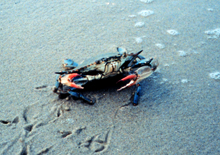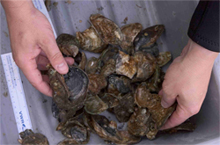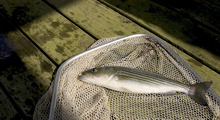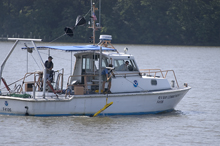It Takes an Ecosystem to Sustain Fisheries:
Developing Ecosystem-based Management at the NOAA Chesapeake Bay Office
The Chesapeake Bay is North America’s largest estuary, and its biological diversity is remarkable. For centuries, the Chesapeake’s rich ecosystem has supported major fisheries that have played a central role in the region’s economy and culture. But, in recent decades, the populations of many of these fish and shellfish have declined dramatically. To turn the situation around, scientists and policy specialists at the NOAA Chesapeake Bay Office are helping to develop new science and innovative management methods to protect and restore the Bay’s living resources and habitats.
The Chesapeake Bay’s Native American inhabitants called the waterway Chesepioc, which means “Great Shellfish Bay.” Since well before John Smith’s exploration of the Chesapeake in 1609—when oyster reefs were so large and plentiful that boats had to navigate around them—the Bay has been a source of many resources for area residents and visitors.
More than 16.5 million people live in the Chesapeake Bay’s 64,000 square-mile watershed, with an additional 100,000 people moving to the area each year. The watershed includes parts of New York, Pennsylvania, Delaware, Maryland, Virginia, West Virginia, and Washington, DC. The rapidly increasing population places growing demands on the ecosystem.

The Chesapeake Bay is home to more than 3,600 species of plants and animals, including the blue crab (Callinectes sapidus). Female blue crabs can be distinguished by the red tips on their claws.
The Chesapeake Bay ecosystem, including its fisheries, faces mounting stresses resulting from human development, including increased air and water pollution, overfishing, and habitat degradation. These stresses cause imbalances in the ecosystem. As a result, abundances of blue crab, oysters, menhaden, and other economically valuable Bay species are declining—in some cases, dramatically so. The habitat of these species is also in danger.
Today, NOAA scientists and policymakers have developed and are implementing an ecosystem-based approach to fisheries and aquatic resource management to help restore living resources in the Chesapeake Bay. The NOAA Chesapeake Bay Office (NCBO) is serving as a "test bed" for development of new concepts in living resource management that take into account interactions among critical components of the Bay ecosystem.
What Challenges Face the Chesapeake Bay?
Among the known and presumed causes of most long-term fishery declines in the Chesapeake Bay are fishing and other human-made modifications and stresses to the Bay and its watershed.
Nutrients
The Chesapeake Bay Program, in which NOAA is a principal partner, has identified excess nutrients (mostly from non-point sources, including runoff and atmospheric deposition) as a major cause of the decline in the Bay’s water quality. Although nutrients are essential for plants and animals, having excessive nutrients in the Bay can be harmful. Excess amounts of nutrients, including phosphorous and nitrogen, fuel rapid growth of tiny plants called phytoplankton.

The blue crab uses submerged aquatic vegetation (SAV) for refuge from predation and as a place in which to feed on small forage fish and detritus. SAV is especially critical as a refuge for the blue crab to hide in during molts, when the crab sheds its old shell and begins to form a new one.
Blooms of phytoplankton can be so dense that they block sunlight to Bay grasses and other plants. Without enough sunlight, these grasses and plants cannot produce food needed to survive. Underwater grasses are important to the Bay ecosystem because they serve as a nursery for juveniles and as a refuge from predators for many Bay residents, reduce sedimentation and erosion, and help filter the water.
Also, phytoplankton and algae ultimately will sink and be decomposed by bacteria in a process that depletes oxygen from bottom waters. When oxygen in water is depleted, fish and other species will die unless they move to other areas of suitable habitat.
Oyster Depletion

Oysters are an important part of the Chesapeake Bay ecosystem because they filter water and form reefs that provide habitat for other ecosystem members. Click image for larger view.
Various factors, such as sedimentation from runoff which can cloud water and block sunlight from reaching underwater grasses, decades of overfishing, and disease, have caused the collapse of oysters and the loss of oyster reefs in the Bay. This loss of oysters contributes to declining water quality. Oysters are an important part of the Chesapeake Bay ecosystem because they consume algae and other waterborne nutrients—each healthy oyster can effectively filter up to one gallon (five liters) of water per hour. Such changes have altered habitats and biological communities in the Bay and, consequently, its potential as a viable fisheries ecosystem.
Other Human Activities
The Bay’s living resources and their habitats have also been degraded by heavy fishing, dredging operations, shoreline modifications related to residential and commercial development, and construction of dams and other impediments to migrating fish. These changes have altered the population size and structure of species of fish that are important in the ecosystem as predators or prey.
Planning for Ecosystem-based Management in the Bay

Scientists at the NOAA Chesapeake Bay Office work to characterize habitat so restoration activities can be targeted and effective. Click image for larger view.
Ecosystem-based fisheries management is unique because it requires coordination among other Chesapeake Bay restoration and protection efforts. Because the health of fish populations and the associated commercial and recreational fisheries reflect the effects of water quality and habitat on ecosystem function, ecosystem-based fisheries management serves as a driver and an integrator for resource management efforts throughout the Bay and its watershed.
NCBO successfully led a collaborative effort of regional scientists and fisheries managers to develop the report: Fisheries Ecosystem Planning for Chesapeake Bay. This report provides valuable guidance for ecosystem-based fisheries management in the Bay and coastal region and describes the structure and function of the Chesapeake Bay ecosystem, including key habitats and species interactions. This information allows fisheries managers to be aware of the effects their decisions have on the ecosystem and the effects other components of the ecosystem may have on fisheries. The report serves as a guide to ecosystem-based approaches to individual fishery management plans and includes recommendations for implementing these plans. It also recommends specific research that will help scientists in the future use their knowledge to support the entire ecosystem.
The following are some of the topics explored in the report:
- Delineation of ecosystem boundaries: As an estuary, the Chesapeake Bay is strongly influenced by open connections with the surrounding land and Atlantic Ocean. Delineating precise boundaries for this ecosystem is challenging.
- Conceptual model of the food web: The Chesapeake Bay food web has undergone significant changes over time, including natural changes as well as changes caused by humans over the last 300 years. A variety of modeling approaches can help us better understand these interactions.
- Description of habitat requirements: Habitat is the medium in which individual species interact within the Chesapeake Bay ecosystem.
- Indices of ecosystem health: Development of integrated, comprehensive indicators of ecosystem health will help in applying ecosystem approaches to management.
- Ecosystem effects on fishing (externalities): The Chesapeake Bay is a relatively stable and shallow estuary, so it is particularly susceptible to both hydrological (for example, a large spring rain event) and human-made (including dams and canals, nutrient and sediment loads, and contaminants) influences.
- Social dimensions of the fisheries ecosystem: Human involvement in the Bay ecosystem extends well beyond fishing to include other businesses, industries, and activities such as transportation, boating, swimming, sewage disposal, and agriculture.
- Economic drivers of the fishing industry: The Bay’s commercial fisheries provide nearly $160 million in value and more than 226,000 metric tons of landings. Industry-related employment is generated not just through the actual fishing process, but through restaurant and food-service businesses. Expenditures on recreational fisheries in the Bay have averaged more than $300 million annually in recent years.
Adopting the Plan
In November 2005, NCBO and its partners secured the Chesapeake Executive Council’s formal endorsement of an ecosystem approach to fisheries management and adoption of Fisheries Ecosystem Planning for Chesapeake Bay as the guiding document for implementing ecosystem-based management in the Chesapeake Bay. Revisions to existing Bay-wide fisheries management plans are under way, to begin the transition from traditional single-species plans, to multi-species plans, and finally to true ecosystem-based fisheries management plans. NCBO is in the forefront of these efforts, providing policy, scientific, and logistical support.

Striped bass are a key link in the Chesapeake Bay food chain. The species is the subject of an ecosystem-based management plan currently under development.
The Chesapeake Executive Council gave first priority to the development of ecosystem-based fishery management plans for oyster, striped bass, blue crabs, Atlantic menhaden, and Alosine species such as American shad. NCBO and its partners in the region are developing fisheries management plans for these species. A draft plan for striped bass is currently under development and, when completed, will function as a pilot.
While these management plans currently have no direct regulatory authority, NCBO is exploring innovative methods, including working with regional management authorities and linking Bay fishery management plans to coastal fishery management plans, to ensure that regional resource managers will effectively implement the plans.
Future Steps

NOAA scientists in the field monitor, analyze, and ultimately support the Chesapeake Bay ecosystem. Click image for larger view.
To further explore how ecosystem-based management can be implemented, NOAA’s National Marine Fisheries Service Office of Habitat Conservation has identified the Chesapeake Bay as the nation’s test bed for development of ecosystem-based management strategies and methods. The Office is exploring how ecosystem approaches to management are being developed and applied in the Chesapeake Bay so that lessons from this experience can be applied to other ecosystems.
NCBO is putting NOAA’s mission—to understand and predict changes in the Earth’s environment and conserve and manage coastal and marine resources to meet our nation’s needs—into action at a regional level.
Working closely with other federal, state, and local partners, NCBO is working to strengthen Chesapeake Bay fisheries for the future.
